Mon-Fri 9am - 5pm Mountain time
American Bladdernut vs Red Alder
Alnus rubra
Staphylea trifolia
CUSTOM GROW
NOT AVAILABLE THIS SEASON - MIGHT RETURN
Red Alder is a fast-growing deciduous tree native to western North America. Through its nitrogen-fixing roots and nitrogen-rich leaf litter, Red Alder improves soil fertility and supports the growth of surrounding plants. This makes it especially valuable on disturbed sites following logging, construction, or fire. A classic pioneer species, it often colonizes bare ground and enhances conditions for longer-lived conifers to follow.
Red Alder stabilizes soils on streambanks and disturbed slopes, reducing erosion and aiding restoration. It also supports wildlife: birds and small mammals eat the seeds and buds, deer and elk browse the foliage, and bees are drawn to the pollen-rich catkins in spring.
Red Alder also has commercial importance, with its strong yet workable wood widely used for furniture, cabinetry, veneer, and pulp. The tree takes its name from the rusty-red color the bark turns when cut or bruised.
American Bladdernut is a fast-growing, ornamental shrub native to eastern North America. It can be grown as a large shrub or trained as a small tree. The small, drooping, white flowers are bell-shaped and grow in clusters. They appear in mid to late spring, attracting various pollinators. Well suited as an understory plant as it prefers shady and partial sun location with moist soils.
The blossoms mature into papery seed capsules and have been described as miniature Japanese lanterns. They are commonly used in dried flower arrangements. The seeds found within the pods are edible, and have a taste similar to pistachios. They can be eaten raw, used in baking or made into a sweet cooking oil.
Care should be taken when planting American Bladdernut, as it can spread quickly. It is prone to suckering and will self-seed. Plant the right tree in the right place.

